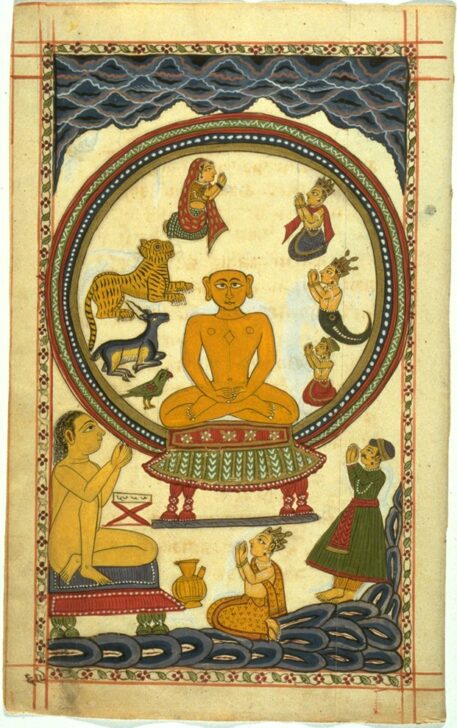Jina venerated by a monk, men and women, a naga, and animals from a Digambara Jain manuscript
Artist Unknown, India, Rajasthan, Sirohi School

Description
Gallery Rotation Spring/Summer 2011
Jina venerated by a monk, layman, and
cobras from a Digambara Jain manuscript
India, Rajasthan, Sirohi School
18th century
Ink, opaque watercolor, and gold on paper
Gift of Dr. and Mrs. Leo S. Figiel and Dr. and Mrs. Steven J. Figiel, 1975/2.171
Jina venerated by a monk, men and women, a naga, and animals from a Digambara Jain manuscript
India, Rajasthan, Sirohi School
18th century
Ink, opaque watercolor, and gold on paper
Gift of Dr. and Mrs. Leo S. Figiel and Dr. and Mrs. Steven J. Figiel, 1975/2.170
In the Jain religion, book production reflects the integral relationship among the laity, monastic community, and the Jina, or enlightened Jain teacher. The dedication of sacred books for shrines is required of devotees, and while commissioning a book fulfills the lay obligation of charity, beholding a book helps the individual achieve the proper mental state for spiritual guidance. It was customary for a lay donor to commission a copy of a text for presentation to his spiritual teacher and ultimately to the temple library.
In these colorful pages, both the golden-hued Jina seated on a simple throne and the monk who venerates him are naked, identifying them as Digambara (sky-clad) Jina. On one page, the Jina is surrounded by Jain devotees: a naga (half human, half serpent), animals, royalty, and lay people. In the lower register the monk leads two men in prayer. On another page, another sky-clad (nude) monk prays to a Jina elevated slightly above him. Below them a lay person in a lotus pond holds prayer beads and looks toward the monk as if for guidance. Cobras often appear in Jain texts and imagery as an obstacle to overcome, and in this image two cobras rise ferociously before the devotee.
Subject Matter:
This is an illustration in a Digambara Jain manuscript of verse 34 of the Bhaktamara Stotra.
This verse praises the glorious halo that surrounds the Jina on his Enlightenment. The presence of the halo is one of the eight pr?tih?rya or so-called miraculous manifestations that accompany the Jina after his Enlightenment. Here the verse describes how the Jina’s halo of light puts to shame all the heavenly bodies. Greater than a multitude of suns, it is also gentler than the moon at night. The poet means to say that the light of the Jina’s halo is comforting not burning, something that is said in Sanskrit poetry of the light of the moon. At the same time, the light of the Jina is as brilliant as the light of countless suns. And by this seeming paradox the poet tells us that the light of the Jina’s halo is not of this world. The halo with its concentric circles also suggests the miraculous preaching assembly, which in turn alerts us to the marvelous appearance of the halo. Like the preaching assembly it is filled with beings of different realms of rebirth: humans, animals, and gods. The small crowned figure at the bottom worshipping the Jina is probably the god Indra.
Physical Description:
A Jina is encircled by a giant halo of ref, green, blue, gold, and white. Within the halo are different creatures, including a tiger, bird, naga, and devotees. The Jina sits nude on a throne with his legs crossed and hands together. Above him are clouds in the sky, and below a monk and devotees.
Usage Rights:
If you are interested in using an image for a publication, please visit https://umma.umich.edu/request-image/ for more information and to fill out the online Image Rights and Reproductions Request Form.